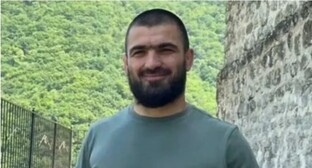09 January 2012, 23:00
Week in the Caucasus: review of main events of January 2-8
Human rights defenders criticize the Georgian Code of Administrative Offences; protest action of Vladikavkaz residents against operation of "Electrozink" Factory; Orthodox believers of the Caucasus celebrate Christmas; complaint of Azerbaijani UN representative against violations of ceasefire in Karabakh conflict zone; first in the new year skirmish in Chechnya and Kabardino-Balkaria with casualties and victims, - look these and other events in the Caucasus in the review of the week of January 2-8, 2012, prepared by the "Caucasian Knot".
Georgia: HRW criticizes Georgian Code of Administrative Offences
On January 4, the Human Rights Watch (HRW) published its report entitled "Administrative Error: Georgia's Flawed System for Administrative Detention", which analyzes the Georgian Code of Administrative Offences. Many provisions of the Code are legally untenable and violate human rights, the HRW believes, and urges the Georgian authorities to amend the document towards proper guarantees of detainees' rights.
The current Georgia's Code of Administrative Offences was adopted in 1984, but since then, it has repeatedly amended. After analyzing all the changes, experts of the HRW have concluded that they had failed to meet international standards.
Most people in Georgia agree with the HRW's report and believe that the current Code of Administrative Offences is obsolete, said Kakha Andjaparidze, Deputy Chairman of the Parliamentary Committee on Legal Affairs. According to his story, the Parliament of Georgia intends to adopt quite a new Code of Administrative Offences, which has been considered there the first reading.
North Ossetia: residents of Vladikavkaz demand to stop "Electrozink" Factory
On January 5, Vladikavkaz hosted a sanctioned protest action against operation of the "Electrozink" Factory, which was attended by about 150 persons. Young people dominated the ranks of picketers.
They held posters "Electrozink: metallurgy or chemical experiment on population?", "Stop 'Electrozink'!", "For ecology and health without politics!", "Save us and future generations of Ossetia!", "Ensure sanitary zone under the law!" "100,000 people live in Vladikavkaz on land contaminated by 'Electrozink'!". Activists addressed passers-by and disseminated copies of documents with information about the negative impact of the factory on human health and the environment.
"Our goal is to ensure that people see, get interested and come here next time," said the picketers.
In late December of 2011, residents of the capital of North Ossetia, who had earlier held protests calling the authorities to pay attention to the problem of air pollution by the "Electrozink" Factory, which, in their opinion, emits huge volumes of heavy metals into the environment, addressed the Public Chamber (PC) of the Russian Federation with a complaint against a restart of harmful emissions into the atmosphere by the "Electrozink". The local "Rospotrebnadzor" (Russian Federal Agency for Consumer Supervision) confirmed the facts of environment pollution in Vladikavkaz.
It should be noted here that representatives of the Holding UMMC (Ural Mining and Metallurgical Company - the owner of the "Electrozink") do not deny the harmfulness of the factory for the environment and agree to hold monitoring and install automated systems to control emissions to be controlled by the "Rospotrebnadzor" and "Rosprirodnadzor" (Russian Federal Agency for Nature Protection).
Orthodox Christians of the Caucasus celebrate Christmas
On January 6, the Russian and Georgian Local Churches celebrated the Christmas Eve - the eve of one of the major holydays - the Christmas.
At night on January 7, believers marked their Orthodox Christmas. The night Christmas services took place in many towns and cities of the Southern and North-Caucasian Federal Districts (SFD and NCFD) of Russia. A distinctive feature of celebrations in Krasnodar was the live broadcast by Channel Nine of the service at the St Catherine Cathedral; while the authorities in Rostov-on-Don increased the night public transport on that day. Safety issues were given special attention in all the regions.
In Armenia and Nagorno-Karabakh, the Armenian Apostolic Church celebrated the Birth of Christ at the same time with Baptism under the common name of Epiphany on January 6.
On January 7, Tbilisi and other Georgian cities held Christmas marches named "Alilo". The march in Tbilisi attracted several thousands of believers, who gathered in Revolution Square and marched along the central Rustaveli Avenue. One of the main roles was given to children dressed in white garments. Also, the marches were attended by the clergy, who were carrying icons, crosses and flags. They were followed by believers on foot and in carts drawn by oxen.
Holiday prayers in honour of the Christmas were conducted in the churches of Abkhazia, South Ossetia, and Azerbaijan.
Karabakh conflict zone: Azerbaijan complains to UN on ceasefire violations
On January 7, Agshin Mekhtiev, Permanent Representative of Azerbaijan to the United Nations, sent a 12-page letter to the UN Security Council and Secretary General about violations of ceasefire by the Armenian party. The letter states that "in October and November, the Armenian Armed Forces broke the ceasefire for 102 times. As a result, five soldiers of Azerbaijani Armed Forces were killed; and a civilian was wounded."
So far, the Armenia's position regarding the letter and the accusations contained therein is unknown. However, in December 2011, officers of the Defence Army of Nagorno-Karabakh reported that within a week only their Azerbaijani counterparts broke the ceasefire at the contact line for more than 185 times.
Let us note here that the parties of the Karabakh conflict are regularly accusing each other of violating the ceasefire. Meanwhile, the monitoring sessions of the contact line, held by the OSCE, as a rule, reveal no violations.
Chechnya and Kabardino-Balkaria: people lost and wounded in shootings
After the New Year, the two republics of Northern Caucasus saw several armed incidents with casualties and victims.
On January 8, a source from power agencies of the Chechen Republic reported that a group of armed persons had been detected in the mountain-and-forest area near the village of Dyshne-Vedeno in the Vedeno District; when power agents tried to approach them for identification, they opened fire at law enforcers. According to unofficial data, three servicemen of the internal troops and police were killed; and 16 more policemen were wounded. Also, three suspected members of illegal armed formations (IAFs) were liquidated.
On January 5, in the foothills Achkhoi-Martan District of Chechnya, an armed clash burst out between servicemen of the internal troops of the local MIA (Ministry of Internal Affairs) and a group of suspected IAF members. No data about losses of both parties has been disclosed.
On January 7, as a result of a skirmish at the DPS (road-and-post service) post in Nalchik, the capital of Kabardino-Balkaria, two policemen and a local resident Alim Chechenov who attacked them were killed; three more traffic policemen and a civilian were wounded. According to the police, Chechenov took a submachine gun away from a DPS inspector and opened fire at the policemen. The wounded civilian was a medical student from St Petersburg: he was wounded when rendering help to another victim.





Комментирование через Кавказский узел